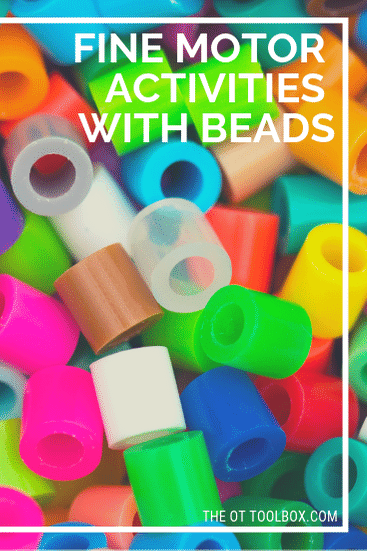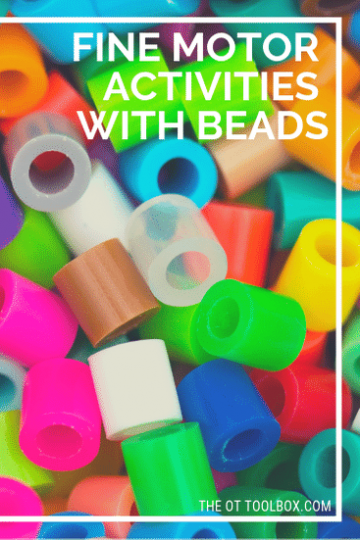There are many great ways to positively affect balance skills, and using specific balance activities for kids that impact gross motor coordination and other areas of development. This article also includes various balance activities for preschoolers, toddlers, focusing on balance skills for all ages!
In this post, you will find balance activity ideas tailored to different age groups with ideas for upgrades and downgrades to meet the individual needs of a variety of children. You will find activities for toddlers, preschoolers, and kids. Some activities can be used during therapy treatment, at home with families, or in the school classroom.
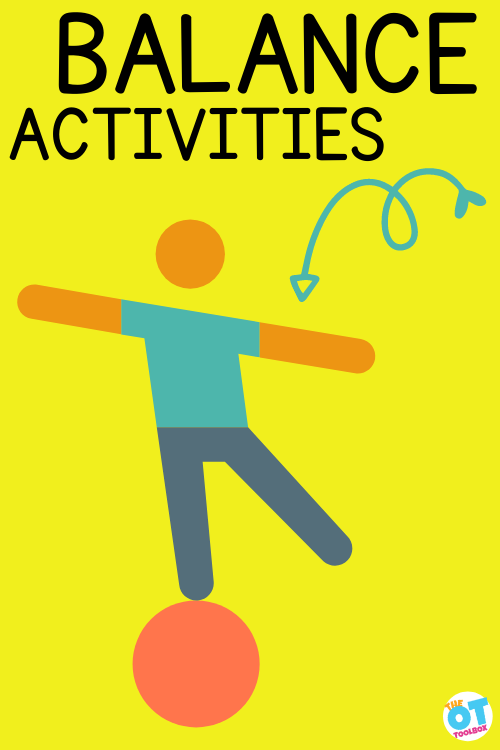
Balance activities for kids
Balance skills are important skills for children to have as children must control and maintain multiple body positions in their daily life functions. They rely on balance for daily activities such as dressing, going to the toilet, navigating each environment, sitting to eat meals, and playing.
They need good balance to engage in sports and games that they play with others to be safe and minimize fatigue. Good balance skills also minimize injury as the child can more successfully utilize protective responses when needed.
Begin by reading this resource on the development of balance.
When addressing balance skills, many times this also includes:
In addition to these areas of consideration, there is also the functional aspect. In order to complete functional tasks throughout the day, or daily occupations, there needs to be movement, manipulation of objects, while maintaining or performing tasks with balance and coordination. So, balance activities are a win-win for the children and you as the provider!
What is Static Balance and Dynamic Balance?
There are forms of balance that include static and dynamic movements and a combination of both which are all utilized frequently in everyday life.
What exactly are static and dynamic balance?
Static balance- Simply put, static balance is when you hold your body stationary in a position or posture.
Building static balance first is where to begin, as this is what provides a good foundation of balancing skills before moving on to more complex balancing with movement.
Examples of static balance is sitting on a stoop, standing in place, holding a plate in the lunch line…
Dynamic balance- Dynamic balance is when your body is in motion. You need both to engage and maneuver through daily activities.
Once you have static stability and control you can start to use movement within it, first, closer to the base and then working further outside of the base.
An example of this might be navigating up or down bleachers, holding a stack of books and items while walking in a line at school, yoga poses…this is just the beginning of examples of dynamic balance.
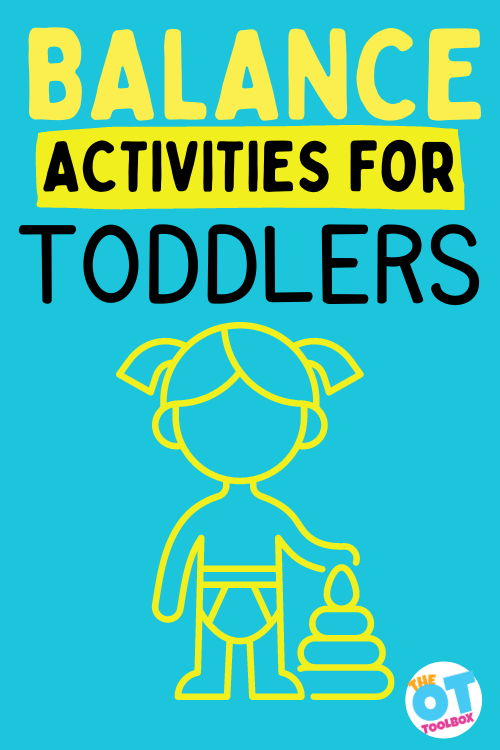
Balance Activities for Toddlers
Moving through the toddler years involves much progression in the development of skills. Toddlers gain more control over the movement of their body in the world around them.
Toddler balance presents as moving through the environment safely and while carrying objects, and gaining skills in walking on uneven surfaces, gaining steady ability to move up and down stairs, changing positions, stepping over objects, sitting on a chair or couch with upright balance, putting on and taking off clothing, and many other aspects of toddler skill development.
This occurs through play and participation in daily tasks, but you can facilitate balance skills in toddlers by offering play based activities that challenge the systems mentioned above.
Pillow on the Floor – Easily challenge a toddler’s balance skills by having them step and stand on a pillow on the floor. This can be a couch or bed pillow or even a couch cushion.
Bubble Burst – While the child is sitting, blow some bubbles to have them reach outside of midline to pop a single bubble on the bubble wand or upgrade to have them reach in all directions to pop as many bubbles as possible. Want to challenge sitting balance more? Have them sit on a less stable surface such as a bench without back support (maybe their feet do not touch the floor completely), a sensory cushion on the floor, or a small peanut ball.
Freeze – Play a game of freeze by playing music and then suddenly stopping it to have the child freeze and hold the position. You can downgrade to have them do this while sitting and then upgrade to have them do this while standing in one place and then upgrade it further by having them do this while moving around the room.
Bean Bag Pathway – Place bean bags in a path along the floor and have the child step on each of the bean bags with alternating feet to challenge their balance in a safe way.
Laundry Basket Run – This is a fun way to engage toddlers in balance in a variety of positions such as standing, sitting, or kneeling. Simply place the child inside of a laundry basket and easily push them along the floor to help them work on their balancing skills in all positions. Sitting will be the easiest and standing will be the most difficult. Always be alert to their safety in the basket, especially while standing!
Cross Crawl Exercises– Use these balance tasks to work on single leg stance, motor planning, standing balance activities, and challenges to core strength. You could also stand on an unstable surface while doing the cross crawl exercises or sit to target sitting balance.
These activities support lower extremity strength needed for balance!
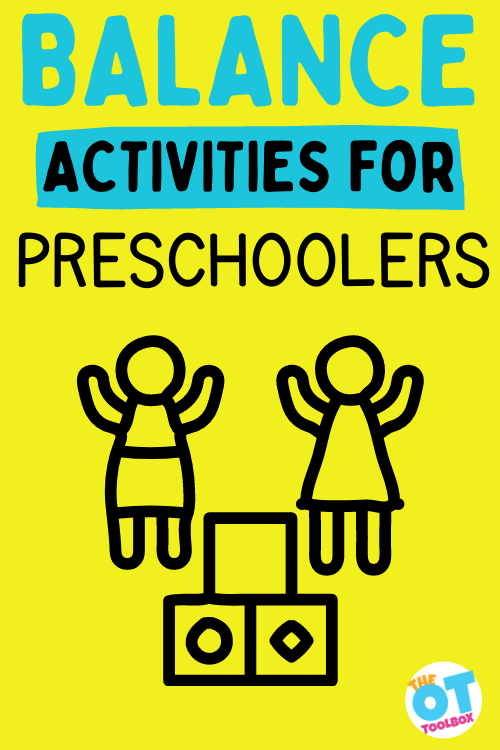
Balance Activities for Preschoolers
During the preschool years, children aged 3-5 gain even more motor control. They also develop cognitively and have a sense of purpose and develop in executive functioning skills at a considerable rate.
Preschool balance presents as kicking, jumping, skipping, hopping, galloping, and other motor skills. You’ll see preschoolers learn to pedal and ride bikes, manage steps with alternating feet, walk on stairs without holding onto a banister, moving through position changes, standing on one foot, holding and carrying objects, standing to get dressed and undressed, and many other aspects of preschool development with more advanced balance skill work.
Preschoolers continue to build these skills through play and various experiences, but you can offer more ways to strengthen balance skills using these balance exercises for preschoolers.
Bubble Burst – Yep, that’s right, use bubbles for balance again because what preschooler doesn’t like bubbles? Use this fascination with bubbles to your advantage and help them work on balance skills too! Simply blow some bubbles and have the child try to step on them once they land on the floor. You can upgrade by having them pop more than one bubble at a time as they attempt to stomp as many bubbles as possible. You can further upgrade by having them step down from an elevated surface and pop a single bubble or multiple bubbles.
Twister Time – Play a game of Twister to challenge balance skills in children. The simple design of this game is a balance barrage of fun! You can downgrade by simply just having them use their feet to step, hop, or jump on the colored dots. You can upgrade the game by playing as designed with the use of hands and feet.
Kneeling – Play a bubble burst game with children either half-kneeling or full kneeling to challenge their balance skills. You can start with simply trying to pop bubbles using one hand and then upgrade to having the child reach to pop bubbles with two hands. Add a pillow while kneeling to add an extra element of challenge.
Stairs and Curbs – The use of stairs and curbs are the perfect tool for practicing balance skills. Simply attempting to walk up the stairs with one foot on each step starts the balancing work. Upgrade the activity by having children perform freeze play on the stairs with one foot on a step above the other. Children can also work on not holding the handrail, with an adult positioned behind them for safety, while walking on the stairs. Have a child walk along the edge of a curb as a fun way to work on tight rope walking. Downgrade the activity to have the child simply work on stepping up and down off the curb.
Big Foot Walk – This is a fun way for preschoolers to work on balance skills while walking in big shoes. Let them choose a pair of adult shoes to don and wear as they walk across the room. It’s an old pastime activity that still has value for young children today as they challenge their balance while walking and stepping. Don’t have adult shoes they can keep on their feet? Then just use old tissue boxes in the same manner.
Animal Walks- Preschool children are gaining more control over their body and can segmentally differentiate between proximal and distal as well as bilateral sides of the body as they gain more coordinated control. This is a great time to use animal walks to support development! Even better, animal walks support the proprioceptive system by integrating heavy work, which is organizing, so the young child learns more about their body, how it moves, and where it is in space. Try these animal walk ideas with themes:
- Jungle Animal Heavy Work Activities
- Heavy Work Activity Cards (includes many types of animal walks)
- Spring Themed Heavy Work Activities (slide deck, great for virtual therapy sessions)
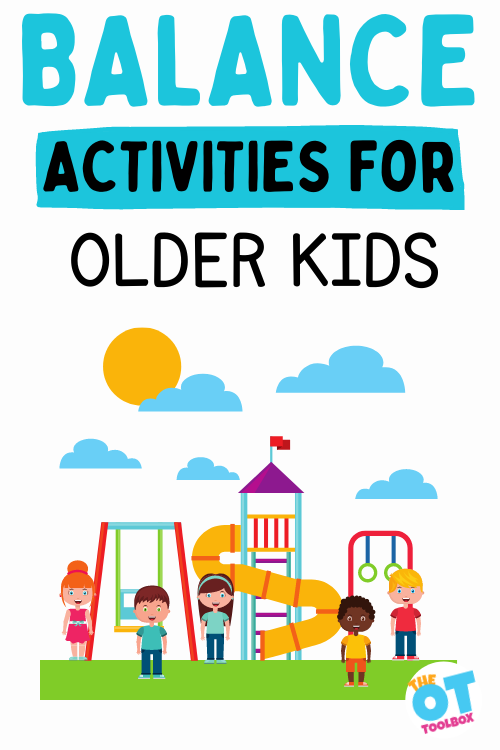
Balance Activities for Children
We covered the toddler and preschool range, but what about supporting older children with balance activities? During the grade school age, or in older ages, balance skills can still be addressed. In older children, you’ll see more advanced motor skills such as riding a two wheel bike, riding a scooter, playing more advanced games, managing bleachers, managing balance at the playground, carrying food trays at lunch time, and other balance tasks.
Balance Cushion Activities – This blog post has multiple ideas for the use of balance cushions and the development of balance skills. Also, an upgrade could include the child attempting to stand with one foot on each cushion to complete activities as this will challenge their balance more intensely by giving the child different wobble movements for each foot to manage.
Pool Noodle on the Floor – Simply place a pool noodle on the floor and have the child walk heel to toe across the noodle without falling off the noodle. You can downgrade by having the child walk side-stepping along the noodle until they can balance with more skill.
Tape Line on the Floor – Begin by placing a straight tape line on the floor and have the child walk heel to toe across the line without falling off. Create a challenge by placing the tape in a zig-zag line and have them walk heel to toe across this line. Upgrade the activity by having the child walk placing their left foot over the line on the right side and then their right foot over the line on the left side, essentially crossing their legs to walk on either side of the line. Upgrade further by having the child walk over stuffed animals or pillows that are placed along any tape line and challenge further by having them walk backward on any line. You can have children walk or tip toe along the tape balance beam and stop to place paper shapes or objects along the tape lines.
Below you will find a list of balance tape line themes to keep the activity fun and festive:
- Christmas tree- Place tape on the floor in the shape of a triangular tree for changes in direction.
- Snowflake balance beam – Stop while walking on the balance beam and bend or squat to place paper snowflakes along the line.
- Valentine’s- Place tape on the floor in a heart shape. Then ask children to bend at certain spots and place paper heart cutouts along the tape lines.
- St. Patrick’s Day balance beam – Stop and bend to place a shamrock on the tape line.
You can also easily create a paper balance beam using die-cut images placed along a line for children to walk on. This is a fun and engaging way for children to work on a skill that may not be easy, but the distraction of the images can facilitate engagement.
Flower Balance Activities- This flower balance activities slide deck resource is a free digital download that encourages balance coordination, motor planning, sequencing, and movement pattern challenges.
Playground Theme Balance Activities- Use this free playground theme therapy slide deck to encourage gross motor skills, sequencing, motor planning, and balance coordination skills, with a playground theme.
Egg Races – Use a small rubber ball to balance on a wooden spoon and have a race across the room without dropping the ball. Upgrade the activity by having the child navigate a path of pillows or blankets rolled up to make an uneven terrain while balancing the ball on the spoon. You can upgrade again by having the child switch the spoon between their hands while standing still or while moving across the room.
Hopscotch – Use the old game hopscotch as a new game again by playing it in different balancing ways to work on a child’s balancing skills. For example, not only hopping as you would normally play but think about changing it up by having the child hop on each number with one foot or have them jump forward and then backward along the board.
Sticker Grab – Place stickers on top of the child’s foot and have them lift their foot to grab the sticker off and place it on paper to create a fun picture. Consider varying the paper placement so that they must reach out of their base of support. They can either stand or sit on an exercise ball when lifting their foot to grab the sticker. Change it up by alternating the feet for sticker grabbing.
Yoga Poses or Animal Moves – Essentially, yoga poses and animal moves are one of the easiest ways to have children work on balance skills as the child must imitate postures and body positions to create the pose or perform the movement. This version of (Amazon affiliate link) The Yoga Garden Game is a fun game for children to play as it is not competitive just cooperative with the goal being just to have fun with one another while learning different poses. No winners and no losers in this game, just FUN!
Try these yoga activities with fun themes that kids love:
Hula Hoop Activities- These hula hoop activities support the development of balance with standing balance challenges, throwing, crawling, and a variety of motor planning tasks.
The Floor is Lava Games- Kids love the floor is lava games! Encourage use of building motor skills, changes in positioning, coordination, etc.
Occupational Therapy and Physical Therapy Balance Equipment
One of the jun parts of OT and PT sessions is introducing fun therapy “toys” (or therapy tools) to work on and facilitate development of skills such as balance skills. Below, you’ll find therapy balance equipment that supports the development of balance in kids. Use these tools in balance activities based on play.
If you need ideas for balance equipment during therapy, below is a list of equipment that can be utilized to develop, challenge, and practice balance:
Amazon affiliate links included below:
- Balance Stepping Stones
- Bucket Stilts
- Coordination Ladder
- Curve Balance Beam
- Foam Balance Beam
- Half Yoga Ball
- Hedgehog Balance Pods
- Hopper Ball
- Peanut Therapy Ball
- Wobble Balance Board
- Wobble Cushion
These DIY therapy balance equipment tools can support skill development at a much cheaper price tag:
- DIY Wobble Disk
- $1 Balance Cushion
- Make a DIY balance beam with a rolled blanket
- Flexible Seating Ideas for the Classroom– some of these ideas can support balance skills too.
Tips to Develop Balance SKills
Each of these items are great tools to use in obstacle courses, relay races, and more. Consider using them in conjunction with one another for changes in balance.
Additionally, here are a few other tips to develop balance skills in children of all ages:
- Other ways to support using these therapy balance equipment items is with a visual schedule for planning the therapy session.
2. Incorporate more skills into balance beams- Use these activities and games along side an indoor balance beam idea or an outdoor balance beam.
3. Don’t forget the power of playing outdoors. The outdoors offer so many opportunities for changes in surfaces, climbing over tree limbs, playground equipment, hills and slopes. Each of these areas can be used to challenge balance. Consider these outdoor sensory activities.
While there are a variety of balance activities included in this post that are mostly for the indoors, don’t forget that you have simple things around you in the outdoors that will engage children in balancing fun without the use of fancy equipment and just the elements of nature!

Regina Parsons-Allen is a school-based certified occupational therapy assistant. She has a pediatrics practice area of emphasis from the NBCOT. She graduated from the OTA program at Caldwell Community College and Technical Institute in Hudson, North Carolina with an A.A.S degree in occupational therapy assistant. She has been practicing occupational therapy in the same school district for 20 years. She loves her children, husband, OT, working with children and teaching Sunday school. She is passionate about engaging, empowering, and enabling children to reach their maximum potential in ALL of their occupations as well assuring them that God loves them!

